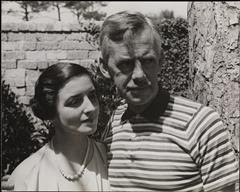 One thing is coming clear with this exploration of How Close Is Too Close, is the way that writers, like jackdaws, grab something bright around them and weave it into their nest of creativity.
One thing is coming clear with this exploration of How Close Is Too Close, is the way that writers, like jackdaws, grab something bright around them and weave it into their nest of creativity. It may be Enid Bagnold's adoption and transformation of a butcher, his gifted swimmer of a wife, and their three daughters, into the dense, complicated and magnificent presentation of family life, animals included, as well as the idea of sacrifice for one, grand, glorious ideal, that is at the heart of National Velvet. It may be the scathing, loving, honest family eye that Pat Conroy turned on his family in so many different novels or the the profound understanding and terrible grief that illuminate the memory plays, The Glass Menagerie, and A Long Day's Journey Into Night. Hoy. Talk about How Close Is too Close?
In Chapter one of O'Neill, Life with Monte Cristo, by Arthur Gelb and Barbara Gelb, they talk about the writing of A Long Day's Journey Into Night, which he wrote shortly after his life had been upended by Parkinson's disease, with symptoms that literally tripped him up physically, at unexpected intervals. At this time, he stopped work on a complex, intertwining cycle of eleven plays about an Irish family and began work on two plays that he knew he could and must write in the time he felt he had left.
 |
| Dillman, Robards, Eldridge and March |
 |
| Florence Eldridge and Frederick March in the original production of A Long Day's Journey Into Night |
O'Neill believed he had achieved a compassionate detachment that would allow him to expiate the demons of his youth while writing of his parents and brother with understanding and forgiveness. And yet he was uneasy in setting out to betray his family's heretofore hidden life. But there was really no way he could not put the story on stage, to portray—as he believed they really were—his parents, brother and himself trapped in an unrelenting dance of death.
 |
| Carlotta and Eugene O'Neill |
It's hard to imagine a family more dedicated to wounding one another. Yet, in an earlier draft, the family was even more vicious.
O'Neill planned to call the play, A Long Day's Journey, Diary Of A Day's Journey and The Long Day's Journey. He said that it was "... a day in which things occur which evoke the whole past of the family and reveal every aspect of its interrelationships. A deeply tragic play, but without any violent dramatic action. At the final curtain, there they still are, trapped within each other by the past, each guilty and at the same time innocent, scorning, loving, pitying each other, understanding and yet not understanding at all, forgiving but still doomed never to be able to forget."
 |
| Jason Robards as Jamie Tyrone |
O'Neill was careful about this play, which had him weeping as he wrote it. The play's dedication states that "this is a work of old sorrow, written in tears and blood." He sent it to his publisher in a sealed envelope with the caveat that it not be opened for 25 years. He did not even copywrite it--he wanted no one to know about it. Even though his father, mother and brother had all died, he was concerned that his oldest son, in particular, would be harmed by learning about their father's family history. After O'Neill's death and his eldest son's gruesome suicide, Carlotta felt that there were no longer reasons to delay the production.
 |
| Eugene O'Neill |
He once said that he did not like life pretty. "Prettiness is only clothes-deep. I am a truer lover than that. I love it naked. There is beauty to me even in its ugliness. In fact, I deny the ugliness entirely, for its vices are often nobler than its virtues, and nearly always closer to a revelation."
Perhaps we are wiser to reveal the naked and the ugly, to exorcise, despite potential wounds, what the world tells us should be prettied away.
No comments:
Post a Comment